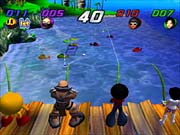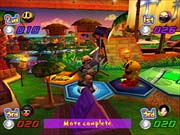Since the original Mario Party landed on the N64 in 1999, major publishers like Sega and Sony have attempted to replicate the success of Nintendo's mascot-driven party game. A generation later, Namco has decided to throw its hat into the ring with its own party game, Pac-Man Fever. Though it features superdeformed versions of some of Namco's more recognizable characters, Pac-Man Fever is basically just another shallow party game.

Holding fast to the typical party game formula, the main mode of play in Pac-Man Fever is laid out much like your average, run-of-the-mill board game. In total, there are three different-themed boards to choose from: tropical, space, and medieval. The selection of minigames is slightly different on each board, but aside from this, the distinctions between the boards are purely cosmetic. At the beginning of each turn, all four players will compete in a minigame, and your performance in this minigame will determine how many squares you'll move that turn. There's a straight path from start to finish, and each square along the way will produce a different effect when landed upon, moving you forward or back on the board, awarding or taking away coins, or pitting players against each other for additional coins. Coins can be used on store squares to move ahead extra spaces, move back other players, multiply the number of spaces you'll move on your next turn, gamble for more coins, or buy raffle tickets. Raffle tickets purchased at the store square give you a better chance of winning the fruit raffle squares. Winning a fruit raffle square rewards you with tickets that can be used at the end of the game to unlock minigames in Pac-Man Fever's other gameplay mode, which strips out the board game elements and lets you get right to the action.
The minigames are the core of Pac-Man Fever, and on the whole they're pretty fast-paced and straightforward, requiring little explanation. The game touts more than 30 different minigames in total, but many of these are simple variations on the same concept, such as collecting items, shooting targets, or participating in a four-way battle. The minigames can be fun for a while, but the generally shallow gameplay mechanics and the repetition of minigame types keeps the game from having much lasting appeal. Pac-Man Fever's other primary fault, much like the board games it draws upon for inspiration, is the pacing. For starters, there are never more or fewer than four players in the game, as the computer will automatically jump in if there are any empty slots. But since the only time that all four players are participating in a minigame is at the beginning of a turn, you'll find yourself doing a lot of waiting around. And though you can determine the length of the board at the beginning of each game, even a short round of Pac-Man Fever lasts around a half hour, which is rather longer than most players will be able to stay engaged in the game.

As can be expected, the presentation of Pac-Man Fever tends toward an upbeat, lighthearted look. All six characters in Pac-Man Fever--Pac-Man, Ms. Pac-Man, Heihachi and Tiger from the Tekken series, Astaroth from Soul Calibur, and Reiko the Ridge Racer girl, are portrayed in superdeformed proportions and generally look pretty good, and the boards represent their respective themes well. There aren't really any major faults in Pac-Man Fever's presentation, though from a technical standpoint, the game simply fails to take advantage of the power of the PlayStation 2 hardware, looking instead like something that could have been produced on the Dreamcast. Everything is modeled at a pretty lean polygon count, and particle and lighting effects are used very sparsely. The sound in the game is also pretty bare bones, consisting almost entirely of background music. Some of the menu music is reminiscent of music found in other Namco games, such as the classic Pac-Man music, which may strike a nostalgic note for some players. The tracks that play during the game itself match up with the different board motifs, but they loop often and abruptly and become quickly annoying.
Pac-Man Fever is basically on par with most other party games from over the years, though it comes much later. The minigames are pretty much on par with the competition, and though there are a few inspired moments, the generally shallow, repetitive gameplay and slow pacing plague Pac-Man Fever just as they have plagued other games in the genre. If you're looking for another party game to tide you over until the next Mario Party, Pac-Man Fever may meet your needs--but if you're looking for an actual party, look elsewhere.